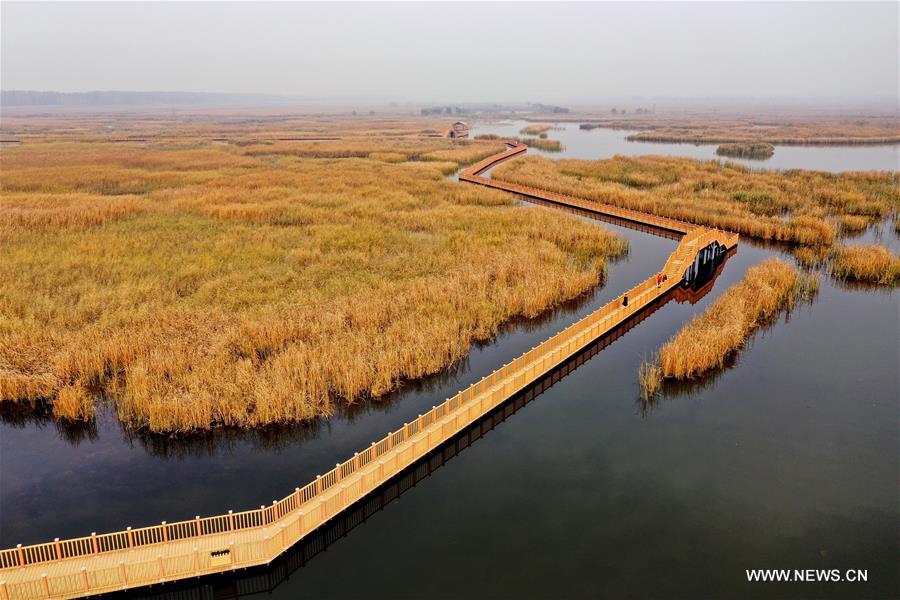In-Situ and Ex-Situ Plant Conservation in China
By Ren Hai Source: Global Times Published: 2020/11/17 18:51:27

Aerial photo taken on Nov. 5, 2020 shows the scenery of the Baiyangdian Lake in Xiongan, north China's Hebei Province. With effective governance, the ecological environment of Baiyangdian Lake has improved a lot in recent years. (Xinhua/Mu Yu)
Plant plays an essential role in maintaining the global environment and supporting human development. China has over 35,000 species of higher plants, about 10% of the world flora, which made it the 3rd largest plant species owner of the world. Besides, China is one of the four origin centers of cultivated plants in the world, and known as the "Mother of World Gardens," China is also one of the countries with the most abundant garden flower plant resources. In recent years, more than 3,800 plant species have been listed as threatened species in China, as a result of habitat loss and fragmentation, over exploitation, alien species invasion, pollution and climate change, as well as reproductive obstacles of plants' own nature. In order to cope with these problems and challenges, to protect, restore and sustainably utilize plant species, China has been one of the few parties which fully implement the strategy of plant protection as soon as China joined the Convention on Biological Diversity (CBD) in 1992. Fruitful work has been progressed in conserving its abundant plant species resources.
It was pointed out in the Progress Report on China's implementation of the Global Strategy of Plant Conservation (GSPC, 2011-2020), that China has now achieved about 70% of the targets set in the Global Strategy for Plant Conservation, and formed a relatively complete plant diversity protection system. China has completed 49 volumes of revised edition of Flora of China (English version). All flora and plant protection information is online, and 96 plant-related databases have been integrated into the National Basic Science Data Sharing Service platform. Taking the lead in completing plant conservation status assessment, China released the "China's Red List of higher plants", with a total of 3,879 species (10.84%) being listed as endangered. China has established a comprehensive protected area system, covering 90% of China's vegetation types and terrestrial ecosystems types. These areas provide protection for 65% of higher plant communities, 85% of wild plant species, and 75% of endangered plants and wild plants with extremely small populations. The 195 botanical gardens in China protected 22,104 native plants in ex-situ, accounting for about 65% of the national total species. China's botanical gardens and arboretums preserve 270 plants listed in the National Key Protected Wild Plants and the Red Book of China's Plants, accounting for 85% and 40% of the species covered by the two lists, respectively. The Wild Plant Germplasm Bank of Southwest China has collected germplasm resources of about 10,000 species of wild plants. Up to the end of 2019, China had successfully reintroduced 206 rare and endangered plants to the wild, making it the country with the largest number of reintroduced plant species in the world.
In his letter of congratulation to the 19th International Botany Congress held in 2017, President Xi Jinping pointed out that "China is one of the countries with the richest plant diversity in the world. Since ancient times, the Chinese people have worshiped nature and loved plants. The Chinese civilization contains a profound plant culture." On the 2018 Global Partnership for Plant Conservation conference held in South Africa, China was ranked as one of the countries with good progress. At the special virtual meeting of Subsidiary Body on Scientific, Technical and Technological Advice of CBD organized by the Secretariat in September 2020, China's implementation of the GSPC was fully recognized.
In the future, China will continue to manage mountains, rivers, forests, farmlands, lakes and grasslands in a holistic approach, carry out major ecological restoration projects, and establish a protected area system with national parks as the main component. More efforts will be made to fully project ecological resources, to investigate and ascertain wild plant resources, to revise and improve laws and regulations such as updating the list of National Key Protected Wild Plants. Law enforcement will be strengthened for the protection of wild plants, and illegal activities that destroy wild plant resources, such as indiscriminate mining and disorderly utilization, will be resolutely curbed. We will strengthen protection and breeding of wild plants and speed up the formation of high-level scientific research teams. China has formulated the Chinese version of the GSPC (2021-2030), which will serve as an important reference for the implementation of the CBD, the realization of the United Nations Sustainable Development Goals in 2030, and the achievement of the 2050 vision of "Living in harmony with nature".
The author is Director at the South China Botanical Garden, Chinese Academy of Sciences
Posted in: ENVIRONMENT